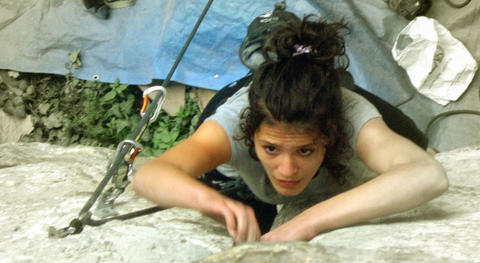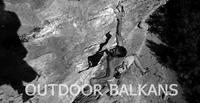
Climbing in Rugova Valley - www.marimangat.org
The Rugova Valley in Kosovo is an ideal place for outdoor activities, especially free climbing. It starts a few kilometres from the city of Peja/Peć , in Western Kosovo. Massimo Moratti has been trying out the “Spiders' Beach” routes
The Rugova Valley lies behind the town of Peja/Peć, an opening in the mountain sides surrounding this Kosovan city on the borders of Kosovo, Albania and Montenegro. This valley is becoming increasingly well renowned as a destination for outdoor tourism for Kosovo and neighbouring countries.
The valley starts just after the Orthodox patriarchy. The narrow road barely finds its way between the dark grey limestone rock faces, with their natural caves once used as fortresses. The River Bistrica-Lumbardhi flows rapidly through these faces.
The first ten kilometres flow through a spectacular gorge cut into sheer rock. The road winds on through natural tunnels, bends, bottlenecks and lay-bys with the river rushing past on one side and the rock faces looming up on the other. Once past the bottlenecks the valley opens out into fields, forests and smaller valleys, and one can see the main valley's most important peaks in the distance: Gjeravica (2656m), the most important summit in Kosovo, Muriashi (2530m), Guri Kuq (2522m) and Hajla (2400m) which are nearer Peja/Peć.
The valley boasts huge potential in tourism which is establishing itself both on a local and international scale. ”Rugova Experience” is an organisation acting as a tour operator which offers complete packages to outdoor holiday enthusiasts, combining both activities and a wide range of accommodation throughout the area. Their aim has been to set up a network of typical accommodation throughout the valley. By contacting “Rugova Experience” you can book the activities along with accommodation in the valley which is provided exclusively by the inhabitants themselves, many of which have come back to live permanently in the Rugova Valley after the exile put upon them during the conflicts.
The Climbing
Sport climbing is undoubtedly one of Rugova Valley's biggest potentials. The rock faces rise up vertically from out of the middle of woodland, with single pinnacles jutting out here and there. The vertical grey limestone is too strong a temptation for climbers; too strong a temptation for the mountain guide and member of the “Trentino con il Kossovo” Association Mauro Barisone, who whilst staying in Peja/Peć some years ago started to open some bolted routes with spits for pure sport climbing, working together with local mountaineer Agim Haqku(Yole).
This initiative was presented to the Peja/Peć community and soon took off thanks to support from Mauro and several Italian mountain clubs who donated equipment, ropes and harnesses and started visiting the area in big groups. Consequently the “Valley Spiders” (“Marimangat” in Albanian language) were founded, being the first climbing club in Kosovo and having its main base in Peja/Peć. The “spiders” offer several activities from adult and children's climbing courses to top roping services, to high altitude activities.
The Cliffs
The club acts as a practical base for climbing in the valley. Its instructors have continued Mauro Barisone's work by opening and pegging new routes. They have managed to open up six different climbing areas with a total of almost 35 opened routes and another 30 routes being set up.
The routes vary in difficulty and length ranging from just a few metres to over 300 metres in length. Most are accessible by car, as they are parallel to the main road. Only a few, such as Jezera, need an off road jeep to arrive or some are about an hour on foot and therefore an ideal opportunity for a two day camping-climbing trip. Others like Drelaj are found nearby to houses within the valley.
Marimangat Beach
The Marimangat cliffs are in an extremely suggestive setting as they are on the narrow river bank tucked in between flowing waters and rock face. We have chosen the area called “Fifth kilometre” which is easily accessible due to its vicinity to the main road. You find a water fountain and a picnic area making it a pleasant resting place to freshen up.
The area has around ten routes of varying difficulties, ranging from grade 3 to 7c, from single pitch routes to ones up to 80 metres long. The rock is solid and well pegged, and you can even climb in the rain thanks to the routes being sheltered by a 7-8 metres' high overhang which doesn't appear to have been climbed as yet.
This is a perfect place for holding introductory courses to rock climbing. The first three or four routes behind the picnic area are on sloping walls particularly suitable for children or beginners. Towards the middle of the wall there is a kind of natural dièdre, corner, and the routes become increasingly more vertical with smaller and more awkward holds.
The two central routes are extremely fun and also the most popular. The first, a 5c, following the central chimney, needs careful and skilful foot and handwork to keep balance and concludes with an elegant move to lead you onto the second route. This second route is a 6a+/6b, and follows a slightly overhanging crack needing a skilful Dulfer move before straightening up and getting easier on the last part.
To the right of this route are the seriously hard routes such as “Trofta”, a 7a-b, or “Las Ketchup”, a 7c, both about 80m long and reserved for the strongest or the Marimangat (the spiders).
On leaving the cliffs and returning down to the town you can see that this valley has endless potential for becoming a top climbing destination in the future. Projects including a metal way are already under way. It will be up to the Marimangat and Rugova Experience to exploit this potential to the full, as they continue their good work in making this valley into an exceptional example of sustainable tourism.








